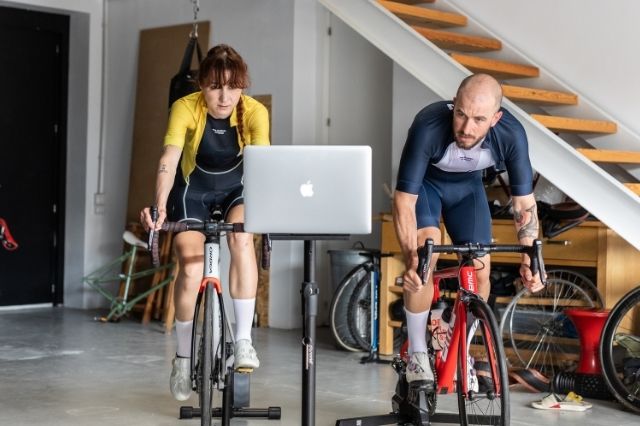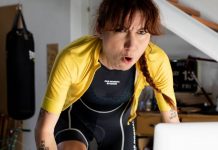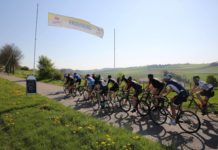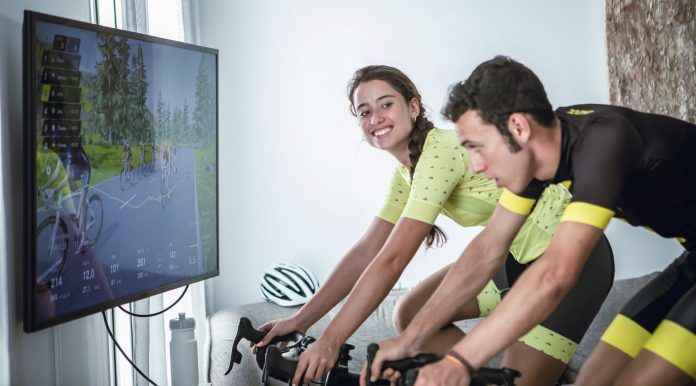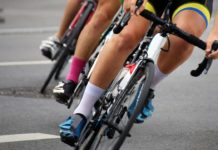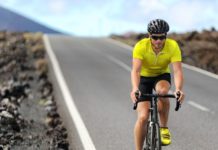Slipstream, also known as “drafting” in cycling, is a technique used to take advantage of the suction generated by a cyclist in front. Thanks to this technique, the cyclist behind takes advantage of the reduced wind resistance and allows more speed to be generated.
However, when it comes to series-specific training on a simulator such as the BKOOL simulator, you may want to deactivate this function. Here’s how to do it so that you don’t get any benefit and are left with the purest training.
In BKOOL, an improved simulation of the slipstream is implemented to provide a more realistic experience and improve the feeling of using this technique. While in real life, in order to stay on the wheel of another cyclist, it is necessary to adjust the speed and sometimes use the brake. In the BKOOL simulation, however, there is no virtual brake. A slight assistance has been introduced that keeps the cyclist in the slipstream automatically.
This gentle assistance adjusts the speed of the cyclist behind to that of the cyclist in front. In this way, it allows you to experience the advantages of the slipstream in the simulator. However, be aware that any sudden change in the pace of the rider in front or the rider behind can take you out of the slipstream. These changes of pace will be visually represented in the simulator.
Is it negative to train with a tailwind in BKOOL?
Training with slipstream on cycling simulators such as those from BKOOL may seem like a tempting strategy to take advantage of the benefits of reduced air resistance and improved pedalling efficiency. However, there are a few reasons why it is not advisable to base your training exclusively on the constant use of the slipstream in this type of simulator. Here’s why.
- Limited realism: It is important to remember that simulators cannot fully replicate the real-life conditions of road racing or training. The speed in a simulator is a simplified representation of the real thing. The benefits and sensations may not be completely accurate.
- Inadequate adaptation: If you get too used to training exclusively with slipstreaming on a simulator, it can affect your ability to adapt to different situations in reality. In an outdoor race, you are likely to encounter variations in speed, wind and other external factors. Training only in slipstream may limit your ability to adjust pace and power according to changing conditions.

- Insufficient skill development: Cycling involves a variety of skills, such as bike handling, navigation, change of pace and group work. Training exclusively on passing can divert your attention away from acquiring and improving these fundamental skills.
- Overestimation of capabilities: Constant use of the slipstream can create a false sense of pedalling ability and efficiency. You may experience greater speed and less effort while benefiting from the drag of the rider in front of you. This leads to a distorted perception of your real abilities.
- Limited focus on heats and individual efforts: The slipstream is useful for team and peloton work, where strategy and group work are essential. However, if your main goal is to improve your individual efforts, the constant use of the slipstream can interfere with accuracy and other session data.
How do I deactivate the slipstream for my series training sessions?
If your goal is to do a series training and you do not want to take advantage of the slipstream in BKOOL, it is important to take into account some considerations. The reduction in air resistance that occurs when riding in the wheel can cause you to gain speed and end up overtaking the rider in front of you, making your sets less effective. To avoid this, you will need to adjust your power or cadence to adapt to the new situation.
It is important to note that in the BKOOL simulation you do not have the option to change direction to overtake. If you want to stay on the wheel of another cyclist, you will have to comply with the required speed and distance without the possibility to change direction.
It is important to note that in pelotons, the advantages of the slipstream are even greater for riders behind a group. Riding behind a group can reduce air resistance by up to 60% compared to the rider in front. However, if your goal is to do individualised series training in BKOOL, turning off the slipstream will allow you to maintain full control over your efforts and get more precise results according to your needs.
BKOOL is the most complete cycling simulator on the market – try it FREE for 30 days!


